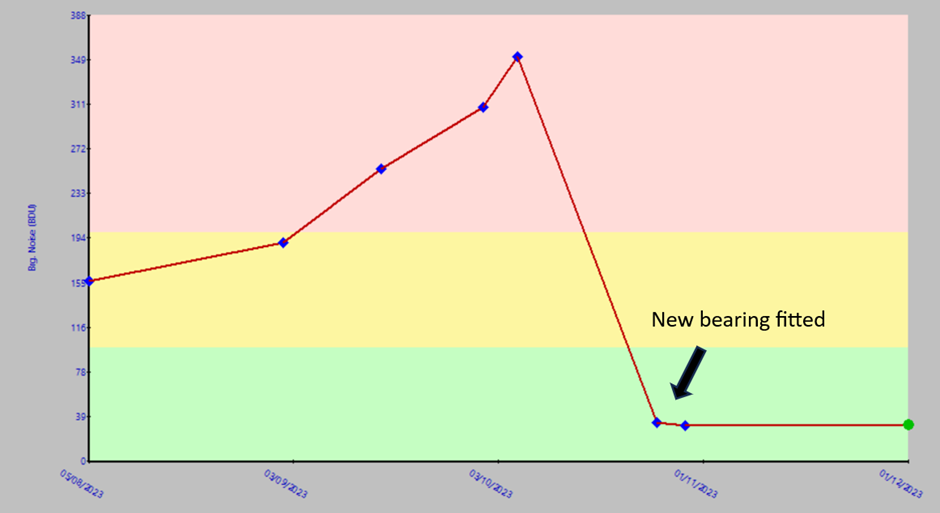
The ISO guidelines for acceptable levels of vibration in rotating machinery form a very good basis for setting alarm levels in the context of Condition Based Maintenance (CBM). These levels can be used to indicate machine status on a “traffic light” basis, e.g. acceptable (green), warning (amber) and critical (red).
By intention, the ISO frequency range of 2Hz to 1kHz covers the vast majority of rotating machinery typically encountered (motors, pumps, fans etc.) and allows the detection of faults such as unbalance, misalignment and looseness. Uncorrected, these faults will lead to premature bearing failure and potential damage to the machine.
But what about the bearings themselves? How do you know when a bearing needs to be replaced?
The ISO frequency range will not detect bearing wear, unless the bearing is so badly worn it is on the brink of collapse. This is because most bearing noise results from high frequency vibrations of the bearing elements and is in the frequency range above 1kHz, the upper limit of the ISO range. This high frequency vibration is the typical “whine” you hear from a worn bearing. In practice, it is usually inaudible until the bearing becomes so bad it is probably about to fail. Fortunately, a vibration analyser can detect the inaudible bearing noise well before it gets to that point.
Although there are no formally agreed standards for acceptable levels of bearing noise, some “de facto” industry standards have been established to quantify bearing condition, such as the use of Bearing Damage Units (BDU). The BDU reading is the measured high frequency (above 1kHz) vibration acceleration in units of g (Earth’s gravity) multiplied by 100. So 1g = 100 BDU, 2g = 200 BDU etc.
As a “rule of thumb” for typical induction motors running at roughly 1500 RPM in Europe (1800 RPM in North America) vibration analysts consider 1g (100 BDU) as the threshold for a worn bearing. Hence, it is tempting to think of BDU as “percentage bearing wear” for typical motor run speeds. Manufacturers of CBM instruments will sometimes give guidelines for acceptable levels of bearing noise, but to diagnose a bad bearing the best thing to do is to look at the TREND of the BDU readings.
The example VibTrend plot shown here shows the BDU readings of a large bearing on a wire saw. The vibration readings were taken roughly every two weeks and the increase in BDU values as the bearing begins to deteriorate is very clear. The decision was taken to replace the bearing after the reading reached a level of roughly 350 BDU. The readings taken after the bearing was replaced then established an approximately 30 BDU baseline for a “known good” (i.e. new) bearing.
Comparisons between “known good” bearings and bearings that are known to be worn soon enables patterns to be observed. In the case described here, alarm levels for similar bearings were subsequently set at 100 BDU for a Warning (amber) and 200 BDU for Critical (red).

Fortunately, simple-to-use, low-cost vibration analysers capable of trending readings are now available. The TPI 9080 (from £1,100) comes complete with VibTrend PC based trending and reporting software that includes automatic report generation and email notification of alarms, implementing a full CBM solution. The TPI 9080 can store lists (routes) of machines to be measured (up to 1,000) with full vibration waveform and frequency spectrum capture for each.
Routes and readings can be transferred between the TPI 9080 and the included, license free, VibTrend software in a variety of different ways. Via the included USB docking cradle, wirelessly via Bluetooth or remotely via a Bluetooth link with a smart phone or tablet running the free TPI Bridge App. This allows service personnel to receive routes and return readings, no matter where they are in the world.
For more information please contact TPI Europe’s head office on +44 1293 530196 or take a look on the website at www.tpieurope.com or email This email address is being protected from spambots. You need JavaScript enabled to view it.



